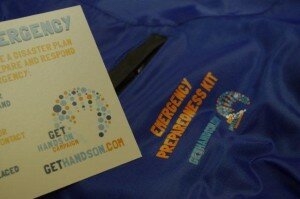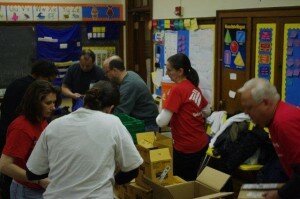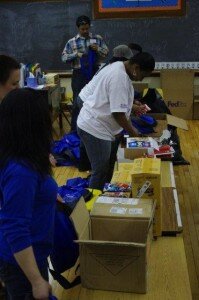 Yesterday we talked about how to put together a disaster preparedness kit. What do you when a disaster hits that requires evacuation, either before the disaster or after? What happens if you and your family get separated during a disaster? Preparing a plan of action in the event of a disaster is an important part of getting through it. Here are some steps you can take before a disaster to help make it through.
Yesterday we talked about how to put together a disaster preparedness kit. What do you when a disaster hits that requires evacuation, either before the disaster or after? What happens if you and your family get separated during a disaster? Preparing a plan of action in the event of a disaster is an important part of getting through it. Here are some steps you can take before a disaster to help make it through.
- Make sure everyone in your family knows how to send a text message on a cellular phone. Text messages can often get around network disruptions when a phone call can’t get through.
- Pick two places to meet outside of your home. One close to your home like a neighbor’s home, and one outside of your neighborhood in case an emergency forces you to leave your neighborhood.
- Pick two out of town contacts for family members to call in case they are separated. Designate one a primary contact and the other a secondary contact.
- Make sure everyone knows the contact numbers and has some way to get in contact with them. If your family members have cell phones, program the contact numbers into them as ‘emergency contact’ instead of their name.
- Post emergency contact numbers near your phone. If you don’t have a home phone, post them somewhere they’ll be easy to find.
- Identify the safe places in your home to take shelter during a disaster. The places might be different based on the type of disaster; your basement is a save place in a tornado, but not in a flood.
- Keep the original version of important documents in a safety deposit box. Keep a copy of them in your disaster kit, and send a copy to be kept with a relative.
- Practice your plan. Practicing your plan allows you to respond quickly and appropriately during an emergency. Try to practice at least twice a year. Practice not only makes the plan more familiar, but gives you an opportunity to check that everything in your disaster kit is up to date.
Visit these pages for more tips for keeping your family safe during a disaster:
FEMA’s Family Communication Plan
Sign up for emergency alert services

 We’re starting to enter the time of year where severe thunderstorms, tornadoes, and flooding will be more common than it was over the winter. Severe storms can pop up with little notice, and you might not have time to get everything you need together in one place before the storm strikes.
We’re starting to enter the time of year where severe thunderstorms, tornadoes, and flooding will be more common than it was over the winter. Severe storms can pop up with little notice, and you might not have time to get everything you need together in one place before the storm strikes. You can even make a volunteer project out of building your disaster kit by
You can even make a volunteer project out of building your disaster kit by  Today’s post comes from Claire Dooms, a Get HandsOn AmeriCorps member at
Today’s post comes from Claire Dooms, a Get HandsOn AmeriCorps member at  When natural disasters strike, it’s amazing how a community, a country, even the world, can come together in light of a tragedy.
When natural disasters strike, it’s amazing how a community, a country, even the world, can come together in light of a tragedy. On Tuesday, April 19 a group of volunteers got together to do just that.
On Tuesday, April 19 a group of volunteers got together to do just that. It was very rewarding to see everyone working together and working out a plan to get things done. Once we finished, I was more than happy to answer their questions about exactly what the purpose of the bags was and how they could get more involved in service work in their own communities.
It was very rewarding to see everyone working together and working out a plan to get things done. Once we finished, I was more than happy to answer their questions about exactly what the purpose of the bags was and how they could get more involved in service work in their own communities. For the last three days, the southern States have been in the grip of a winter storm that dumped snow and ice on states that don’t normally get snow. Another storm system is traveling up the east coast and getting ready to bring even more snow to the Northeast–parts of which are still trying to dig out from storms around Christmas.
For the last three days, the southern States have been in the grip of a winter storm that dumped snow and ice on states that don’t normally get snow. Another storm system is traveling up the east coast and getting ready to bring even more snow to the Northeast–parts of which are still trying to dig out from storms around Christmas.
